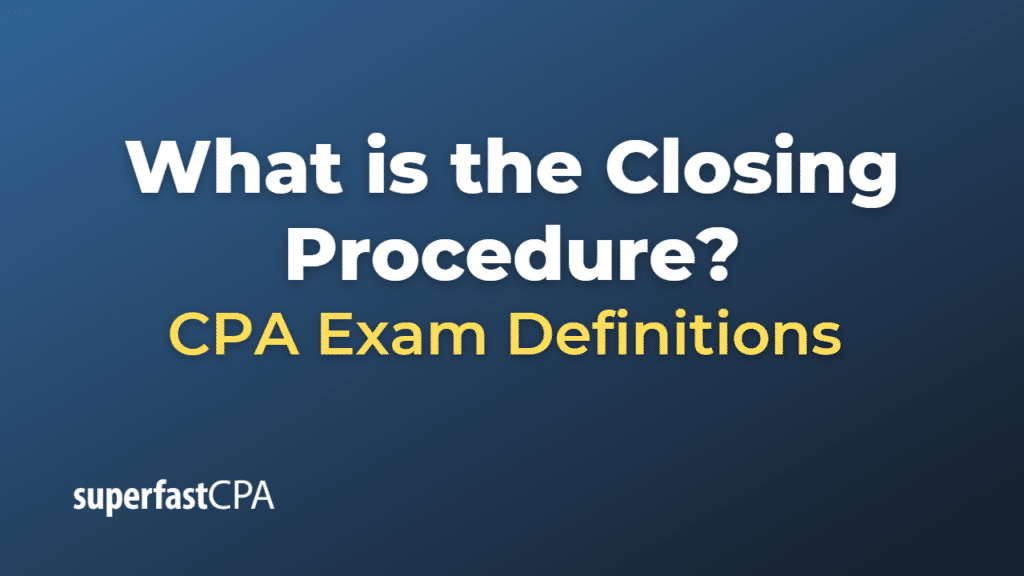Closing Procedure
The closing procedure, in the context of accounting, refers to the process of finalizing financial records and statements for a specific accounting period, such as a month, quarter, or year. The purpose of the closing procedure is to prepare the financial statements, ensure the accuracy of the financial information, reset temporary account balances to zero for the next accounting period, and update the retained earnings account to reflect the period’s net income or net loss.
The closing procedure typically involves the following steps:
- Prepare trial balance: A trial balance is prepared to ensure that the total debits equal the total credits for all accounts. This helps to identify any errors or discrepancies in the accounting records.
- Adjusting entries: Adjusting entries are made to account for accrued revenues and expenses, deferred revenues and expenses, and other adjustments necessary to comply with the accrual accounting method. These entries ensure that the financial statements reflect the correct financial position and performance of the company.
- Adjusted trial balance: After making the adjusting entries, an adjusted trial balance is prepared to ensure that the total debits still equal the total credits and that the financial statements are accurate.
- Prepare financial statements: The financial statements, including the income statement, statement of retained earnings, balance sheet, and statement of cash flows, are prepared using the adjusted trial balance. These statements provide an overview of the company’s financial position and performance during the accounting period.
- Closing entries: Closing entries are made to transfer the balances of temporary accounts (revenue, expense, and dividend accounts) to the retained earnings account, effectively resetting the temporary accounts to zero. This step is essential for accurately recording transactions in the subsequent accounting period.
- Post-closing trial balance: After making the closing entries, a post-closing trial balance is prepared to ensure that the temporary accounts have been reset to zero and that the total debits equal the total credits for the permanent accounts.
- Document and archive: The financial statements, trial balances, and supporting documents are archived for future reference and to comply with legal and regulatory requirements.
By following the closing procedure, companies can ensure that their financial records and statements are accurate, complete, and ready for the next accounting period. This process is essential for providing reliable financial information to management, investors, and other stakeholders for decision-making and performance evaluation.
Example of the Closing Procedure
Let’s consider a fictional small business, “ABC Services,” and demonstrate the closing procedure using the following account balances at the end of the year:
Revenues:
- Service Revenue: $45,000
Expenses:
- Rent Expense: $12,000
- Salaries Expense: $25,000
- Utilities Expense: $3,000
Dividends:
- Dividends Paid: $1,000
Here’s an example of the closing procedure for ABC Services:
- Prepare trial balance: Prepare an initial trial balance to ensure that the total debits equal the total credits for all accounts.
- Adjusting entries: Make any necessary adjusting entries for accrued or deferred revenues and expenses. In this example, we assume that there are no adjusting entries needed.
- Adjusted trial balance: Prepare an adjusted trial balance. In this case, the initial trial balance and the adjusted trial balance will be the same, as no adjustments were required.
- Prepare financial statements: Create the income statement, statement of retained earnings, and balance sheet using the adjusted trial balance.Income Statement:
- Service Revenue: $45,000
- Rent Expense: $12,000
- Salaries Expense: $25,000
- Utilities Expense: $3,000
- Net Income: $5,000
- Beginning Retained Earnings: $0 (assuming the company started this year)
- Net Income: $5,000
- Dividends Paid: $1,000
- Ending Retained Earnings: $4,000
- Assets, Liabilities, and Equity accounts will be presented based on their balances.
- Closing entries: Reset temporary account balances to zero and transfer their balances to the retained earnings account.a. Close revenue accounts: Debit: Service Revenue – $45,000 Credit: Income Summary – $45,000b. Close expense accounts: Debit: Income Summary – $40,000 (sum of all expenses) Credit: Rent Expense – $12,000 Credit: Salaries Expense – $25,000 Credit: Utilities Expense – $3,000c. Close the Income Summary account: Debit: Income Summary – $5,000 Credit: Retained Earnings – $5,000d. Close the Dividends account: Debit: Retained Earnings – $1,000 Credit: Dividends – $1,000
- Post-closing trial balance: Prepare a post-closing trial balance to ensure that the temporary accounts have been reset to zero and the total debits equal the total credits for the permanent accounts.
- Document and archive: Archive the financial statements, trial balances, and supporting documents for future reference and legal or regulatory compliance.
This example demonstrates the closing procedure for ABC Services, ensuring that the financial statements are accurate, and the temporary accounts are reset to zero for the next accounting period.













